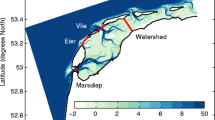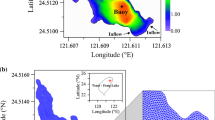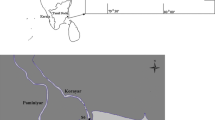Abstract
A numerical model to simulate the transport of suspended sediment in tidal estuaries is presented. The model is applied to the two large European estuaries the Tagus (Portugal) and the Scheldt (Belgium-The Netherlands). Calculated suspended sediment concentrations compare favourably with observations in the Tagus (r=0.84) and in the Scheldt (r=0.73). The parametrization scheme indicates that the bottom content of fine sediment is correlated with depth in the Tagus; but a different relationship is used in the Scheldt. Because of tidal range differences, average suspended sediment concentrations are lower in the Tagus (80 mg l−1) than in the Scheldt (130 mg l−1), but a larger relative variation between spring and neap tide concentrations may occur in the Tagus.
Similar content being viewed by others
References
ALLEN, G.P., J.C. SALOMON, P. BASSOULLET, Y. DU PENHOAT and C. DE GRANDPRÉ, 1980. Effects of tides on mixing and suspended sediment transport in macrotidal estuaries. Sediment. Geol., 26: 69–90.
CANCINO, L. and R. NEVES, 1994. 3D-numerical modelling of turbidity maximum zone dynamics in the Scheldt estuary. Neth. J. Aquat. Ecol. 28: 337–345.
CASTANHEIRO, J. 1985. Suspended matter in the Tejo estuary. Distribution and variability. Environmental Study of the Tejo Estuary, Direcç≈ao-Geral da Qualidade do Ambiente, Lisbon p. 1–29. (in Portuguese).
CASTANHEIRO, J. and J. CRESPO, 1983. Sediment dynamics. Results from the observations made in 1981. Environmental Study of the Tejo Estuary, Report No. 31. Comiss≈ao Nacional do Ambiente, Lisbon, p. 1–65. (in Portuguese).
DRONKERS, J., 1986. Tide-induced residual transport of fine sediment. In: J. van de Kreeke, Ed., Physics of Shallow Estuaries and Bays. Springer-Verlag, Berlin, p. 228–244.
ELLIOTT, M. and J.-P. DUCROTOY, 1991. The future direction of studies on spatial and temporal comparisons of coasts and estuaries. In: M. Elliott and J.-P. Ducrotoy, Eds., Estuaries and coasts: spatial and temporal intercomparisons. Olsen & Olsen, Fredensborg, p. 385–390.
GAUDÉNCIO, M.J., M.T. GUERRA and M. GLÉMAREC, 1991. Recherches biosédimentaires sur la zone maritime de l'estuaire du Tage, Portugal: données sédimentaires préliminaires. In: M. Elliott and J.-P. Ducrotoy, Eds. Estuaries and coasts: spatial and temporal intercomparisons. Olsen & Olsen, Fredensborg, p. 11–16.
GIBBS, R.J., D.M. TSHUDY, L. KONWAR and J.-M. MARTIN, 1989. Coagulation and transport of sediments in the Gironde Estuary. Sedimentology, 36: 987–999.
KRONE, R.B., 1962. Flume studies of the transport of sediment in estuarial shoaling processes. Hydraulic Engineering Laboratory, University of California, Berkeley, p. 1–118.
LANG, G., R. SCHUBERT, M. MARKOFSKY, H.-U. FANGER, I. GRABEMANN, H.L. KRASEMANN, L.J.R. NEUMANN and R. RIETHMÜLLER, 1989. Data interpretation and numerical modeling of the Mud and Suspended Sediment Experiment 1985. J. Geophys. Res., 94: 14381–14393.
MARTINS, M. and M.J.L. DUFFNER, 1982. Water quality study. Results from synoptic observations in 1980. Environmental Study of the Tejo Estuary, Report No. 14, Comiss≈ao Nacional do Ambiente. Lisbon, p. 1–212 (in Portuguese).
MEHTA, A.J., 1989. Laboratory studies on cohesive sediment deposition and erosion. In: J. Dronkers and W. van Leussen, Eds., Physical processes in estuaries, Springer-Verlag, Berlin, p. 427–445.
MEHTA, A.J., E.J. HAYTER, W.R. PARKER, R.B. KRONE and A.M. TEETER, 1989. Cohesive sediment transport. I: Process description. J. Hydraul. Engin. (ASCE), 115: 1076–1093.
MULDER, H.P.J. and C. UDINK, 1991. Modelling of cohesive sediment transport. A case study: the Western Scheldt Estuary. In: B.L. Edge, Ed., Proceedings of the 22nd International Conference on Coastal Engineering. American Society of Civil Engineers, New York, p. 3012–3023.
NIHOUL, J.C.J., F.C. RONDAY, J.J. PETERS and A. STERLING, 1978. Hydrodynamics of the Scheldt estuary. In: J.C.J. Nihoul, Ed., Hydrodynamics of estuaries and fjords. Elsevier, Amsterdam, p. 27–53.
OLIVEIRA, R., 1967. Contribution to the study of the Tejo estuary. Sedimentology. LNEC Technical Paper No. 296, Laboratório Nacional de Engeharia Civil, Lisbon, p. 1–61. (in Portuguese).
PARTHENIADES, E., 1965. Erosion and deposition of cohesive solid. J. Hydraul. Div. (ASCE), 91: 105–139.
PORTELA, L.I., L. CANCINO and R. NEVES, 1992. Modelling of tidal flow and transport processes: a case study in the Tejo estuary. In: P.W. Partridge, Ed., Computer modelling of seas and coastal region. Computational Mechanics Publications, Southampton, p. 449–461.
PORTELA, L.I. and R. NEVES, 1993. Modelling of salt distribution in the Tejo estuary using the QUICK Scheme. In: L.C. Wrobel and C.A. Brebbia, Eds., Water Pollution II: modelling, measuring and prediction. Computational Mechanics Publications, Southampton, p. 121–128.
SALOMONS, W. and W.D. EYSINK, 1981. Pathways of mud and particulate metals from rivers to the Southern North Sea. In: W. Salomons, W.G. Mook and W.D. Eysink, Eds., Biogeochemical and hydrodynamic processes affecting heavy metals in rivers, lakes and estuaries. Delft Hydraulics Publ. No. 253, Delft, p. 1–34.
VALE, C. and B. SDBY, 1987. Suspended sediment fluctuations in the Tagus estuary on semi-diurnal and fortnightly time scales. Est. Coast. Shelf Sci., 25: 495–508.
VALE, C., M.J. GAUDÊNCIO and M.T. GUERRA, 1989. Evaluation of the ecological impact. In: C. Alzieu and B. Gallene, Eds., Proceedings of the International Seminar on the Environmental Aspects of Dredging Activities. Nantes, p. 119–128.
VAN ECK, G.T.M. and N.M. DE ROOIJ, 1990. Development of a water quality and bio-accumulation model for the Scheldt estuary. In: W. Michaelis, Ed., Estuarine water quality management. Springer-Verlag, Berlin, p. 95–104.
VAN LEUSSEN, W. and E. VAN VELZEN, 1989. High concentration suspensions: their origin and importance in Dutch estuaries and coastal waters. J. Coast. Res., 5: 1–22.
VAN MALDEGEM, D.C., H.P.J. MULDER and A. LANGERAK, 1993. A cohesive sediment balance for the Scheldt estuary. Neth. J. Aquat. Ecol., 27: 247–256.
VAN RIJN, L.C., 1989. The state of the art in sediment transport modelling. In: S.S.Y. Wang, Ed., Sediment transport modeling. American Society of Civil Engineers, New York, p. 13–32.
Author information
Authors and Affiliations
Rights and permissions
About this article
Cite this article
Portela, L.I., Neves, R. Numerical modelling of suspended sediment transport in tidal estuaries: A comparison between the Tagus (Portugal) and the Scheldt (Belgium-the Netherlands). Netherlands Journal of Aquatic Ecology 28, 329–335 (1994). https://doi.org/10.1007/BF02334201
Issue Date:
DOI: https://doi.org/10.1007/BF02334201




